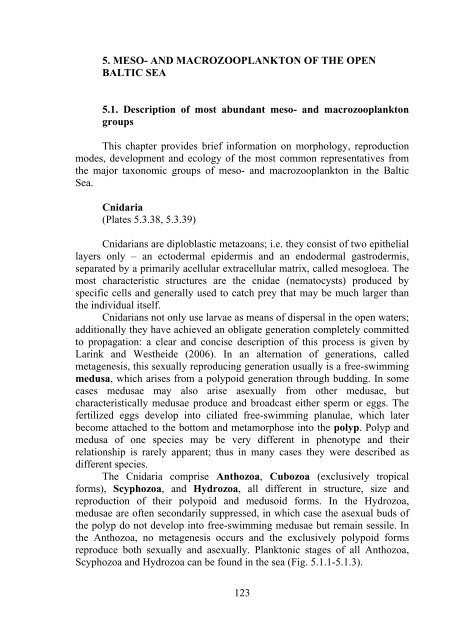Zooplankton of the open Baltic: Extended Atlas - IOW
Zooplankton of the open Baltic: Extended Atlas - IOW
Zooplankton of the open Baltic: Extended Atlas - IOW
Create successful ePaper yourself
Turn your PDF publications into a flip-book with our unique Google optimized e-Paper software.
5. MESO- AND MACROZOOPLANKTON OF THE OPEN<br />
BALTIC SEA<br />
5.1. Description <strong>of</strong> most abundant meso- and macrozooplankton<br />
groups<br />
This chapter provides brief information on morphology, reproduction<br />
modes, development and ecology <strong>of</strong> <strong>the</strong> most common representatives from<br />
<strong>the</strong> major taxonomic groups <strong>of</strong> meso- and macrozooplankton in <strong>the</strong> <strong>Baltic</strong><br />
Sea.<br />
Cnidaria<br />
(Plates 5.3.38, 5.3.39)<br />
Cnidarians are diploblastic metazoans; i.e. <strong>the</strong>y consist <strong>of</strong> two epi<strong>the</strong>lial<br />
layers only – an ectodermal epidermis and an endodermal gastrodermis,<br />
separated by a primarily acellular extracellular matrix, called mesogloea. The<br />
most characteristic structures are <strong>the</strong> cnidae (nematocysts) produced by<br />
specific cells and generally used to catch prey that may be much larger than<br />
<strong>the</strong> individual itself.<br />
Cnidarians not only use larvae as means <strong>of</strong> dispersal in <strong>the</strong> <strong>open</strong> waters;<br />
additionally <strong>the</strong>y have achieved an obligate generation completely committed<br />
to propagation: a clear and concise description <strong>of</strong> this process is given by<br />
Larink and Wes<strong>the</strong>ide (2006). In an alternation <strong>of</strong> generations, called<br />
metagenesis, this sexually reproducing generation usually is a free-swimming<br />
medusa, which arises from a polypoid generation through budding. In some<br />
cases medusae may also arise asexually from o<strong>the</strong>r medusae, but<br />
characteristically medusae produce and broadcast ei<strong>the</strong>r sperm or eggs. The<br />
fertilized eggs develop into ciliated free-swimming planulae, which later<br />
become attached to <strong>the</strong> bottom and metamorphose into <strong>the</strong> polyp. Polyp and<br />
medusa <strong>of</strong> one species may be very different in phenotype and <strong>the</strong>ir<br />
relationship is rarely apparent; thus in many cases <strong>the</strong>y were described as<br />
different species.<br />
The Cnidaria comprise Anthozoa, Cubozoa (exclusively tropical<br />
forms), Scyphozoa, and Hydrozoa, all different in structure, size and<br />
reproduction <strong>of</strong> <strong>the</strong>ir polypoid and medusoid forms. In <strong>the</strong> Hydrozoa,<br />
medusae are <strong>of</strong>ten secondarily suppressed, in which case <strong>the</strong> asexual buds <strong>of</strong><br />
<strong>the</strong> polyp do not develop into free-swimming medusae but remain sessile. In<br />
<strong>the</strong> Anthozoa, no metagenesis occurs and <strong>the</strong> exclusively polypoid forms<br />
reproduce both sexually and asexually. Planktonic stages <strong>of</strong> all Anthozoa,<br />
Scyphozoa and Hydrozoa can be found in <strong>the</strong> sea (Fig. 5.1.1-5.1.3).<br />
123

















